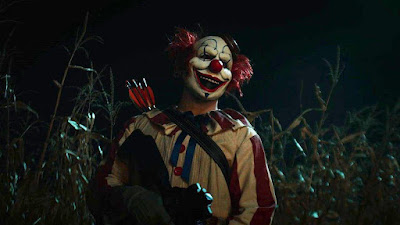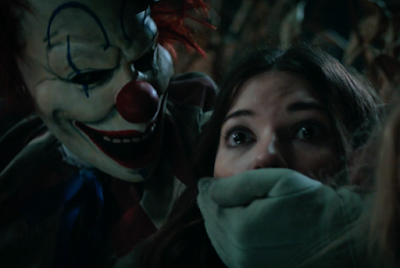A fading midwestern town in which Frendo the clown, a symbol of bygone success, reemerges as a terrifying scourge.
Director Eli Craig’s Clown in a Cornfield is a fast-paced, blood-splattered slasher film that wears its teen-horror influences on its sleeve. Based on the young adult horror novels by Adam Cesare, the film doesn’t strive for reinvention. Instead, it leans heavily into the familiar beats of the genre, offering gory thrills and a few tongue-in-cheek chuckles along the way. While it’s unlikely to surprise seasoned horror fans, it delivers exactly what it promises: masked mayhem in a rural American town, with a side of teenage rebellion and generational resentment.
The story follows Quinn (Katie Douglas), a teenager seeking a new start after the loss of her mother. She and her father relocate to the economically stricken town of Kettle Springs, a community still reeling from the loss of its main employer, the Baypen Corn Syrup Factory, which burned down under suspicious circumstances. The cause of the fire is never proven, but much of the town blames a group of reckless local teens—particularly prankster Cole (Carson MacCormac) and his gang—who have become infamous for their online prank videos filmed among the town’s industrial ruins.
It’s a setup that quickly lays the groundwork for conflict. Kettle Springs is a town divided, with older residents deeply resentful of the younger generation’s behaviour, technology habits, and perceived lack of respect. The film leans into this generational friction, framing it as the central thematic tension beneath the clown-fuelled carnage. The message is unsubtle, but effective: the adults are tired of the kids' antics, and some of them are prepared to go to disturbing lengths to restore order.
Enter Frendo, the film’s iconic killer clown. Emerging ominously from the cornfields, Frendo becomes the masked face of this societal backlash, dishing out gruesome justice to the teens one by one. The character design feels lifted from a long lineage of evil clowns, borrowing heavily from more memorable precedents like Pennywise and Art the Clown. While Frendo’s squeaky shoes add a darkly humorous touch, there’s little else to distinguish him visually or thematically. His permanent grin and tattered clown garb are serviceable, but they lack the flair or fear factor to elevate him to horror icon status.
Where Clown in a Cornfield shines is in its pace and energy. From the outset, the film wastes no time getting to the good stuff. Director Eli Craig maintains a lively tempo, avoiding long stretches of buildup in favour of frequent action. The movie clocks in at under 90 minutes, a runtime that suits its straightforward premise and ensures there’s little room for boredom. Once the killings begin, the film barrels forward with gleeful abandon, barely pausing to reflect on the chaos it unleashes.
The kills themselves are inventive enough to satisfy gore fans, incorporating everyday items like cattle prods and gym equipment in unexpectedly grisly ways. One particularly memorable death involves a twisted take on a weightlifting mishap, played with the kind of macabre humour that Craig previously employed in Tucker & Dale vs Evil. The special effects—mostly practical—are solid given the film’s modest budget. While not as visceral or disturbing as the kills in franchises like Terrifier, they strike a decent balance between shock and comedy.
Yet for all its energy and spectacle, the film struggles to offer anything truly new. The plot follows a well-worn path: a final girl, a group of expendable teens, a masked killer, and a last-act reveal that aims to tie it all together. Unfortunately, the reveal is telegraphed far too early, and any attentive viewer is likely to piece it together well before the climax. The foreshadowing lacks subtlety, and many of the red herrings—though amusing—fail to distract from the film’s predictability.
One of the more intriguing subplots involves the teens using Quinn as the unwitting subject of a fake horror prank, capturing her genuine reactions to what she believes are real deaths. This blurring of the line between performance and reality introduces an interesting layer of misdirection. For a brief moment, the audience is unsure what is real and what is staged. However, the film never fully commits to this uncertainty, and the tension it could have generated is quickly undercut by a return to conventional storytelling.
Katie Douglas is a highlight as Quinn, bringing a mix of assertiveness and vulnerability to a character that could easily have been one-note. Unlike the stereotypical horror heroine, Quinn is confident, quick-witted, and proactive. Douglas’s performance elevates the role, providing a much-needed anchor amidst the chaos. Her interactions with the other characters are sharp and believable, even if many of her peers are thinly drawn archetypes. The film hints at deeper emotional backstories, but these are largely sidelined in favour of action.
This lack of character depth is one of the film’s weaker aspects. While it may be a faithful adaptation of a novel that explores these personalities more thoroughly, the film version sacrifices development for pace. As a result, when characters start to die, there’s limited emotional investment. The audience is never given much reason to care who survives beyond Quinn herself.
Thematically, Clown in a Cornfield takes swings at several contemporary issues—youth culture, internet fame, and small-town conservatism among them. But its commentary is broad and mostly surface-level. There’s an implied critique of both the older generation’s resistance to change and the younger generation’s reckless disregard for consequence, but these ideas never quite cohere into a strong point of view. Instead, they provide just enough context to justify the story’s central conflict.
The film’s final moments are also somewhat deflating. Without giving too much away, the ending leaves several threads unresolved, clearly leaving space for a potential sequel. Unfortunately, this setup feels forced and undermines the tension of the climax. Rather than offering a satisfying resolution, the film seems more interested in hinting at future instalments—a decision that may frustrate viewers looking for a self-contained story.
Despite its shortcomings, Clown in a Cornfield remains an entertaining ride. It knows its audience and delivers the kind of gory fun that fans of teen slashers expect. It may not break new ground, and its scares rarely rise above the expected, but it leans into its absurdity and never pretends to be anything more than what it is.
For viewers in the mood for an uncomplicated slasher with just enough charm and mayhem to pass a Friday night, Clown in a Cornfield fits the bill. It might be built from spare parts, but it runs just fine.
Clown in a Cornfield was released in NZ cinemas on May 8, 2025






